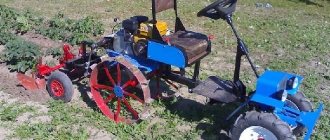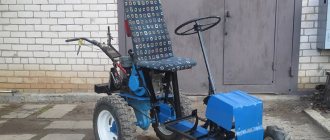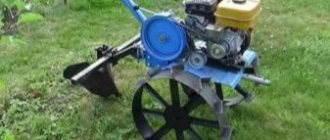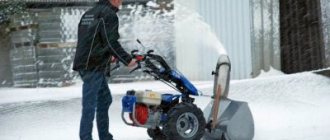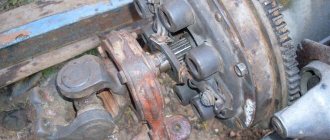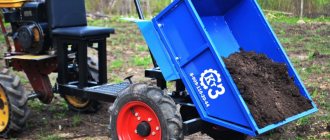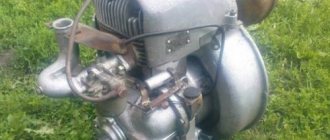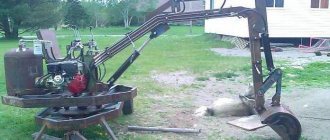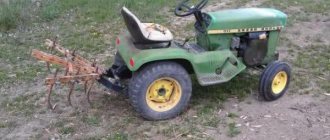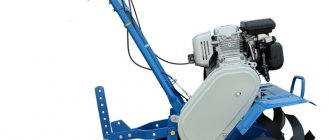Pros and cons of homemade structures
Among the advantages of equipment assembled with your own hands, the following positions can be noted:
- Even a person with low qualifications can make attachments;
- Any mounted unit made in home-made conditions is quite inexpensive;
- to create equipment and repair it, you will need a standard set of tools;
- it is possible to enhance certain features of the device;
- From a safety point of view, attachments can be designed to a very high level.
Among the shortcomings, the following criteria stand out:
- setting up and servicing homemade equipment is a painstaking, labor-intensive process that requires skill and proper qualifications from the owner;
- During the entire service life, special attention is required to monitor the operation of the unit.
Types of units
The use of a mini tractor is primarily represented in the form of an excavator. There are many varieties; for a specific tractor it is necessary to select an excavator model. The main advantage of such attachments is the impressive width of the access angle, the boom rotation by 180 degrees, and the relative ease of attaching hydraulic tips. And having examined all the possible levers, it is clear that this unit is equipped with the most advantageous special single-lever joystick, which ensures a return to the neutral position in automatic mode. And if the bucket teeth break, replacing them will not be difficult, and even a layman can understand how to do this.
Manufacturers have even foreseen the demand for rakes, usually made by hand. Such a device replaces human labor in such types of work as collecting grass and forming haystacks. The tractor rakes up hay on its way, and when its quantity becomes sufficient to form a windrow, it dumps it. A special type was also created and drawings were developed for tedder rakes. They are used to collect grass that has previously been exposed to rain. They automatically rake, ted and wrap windrows. For similar purposes, you can also use a haystack; here you need to consult which suspension is best suited for a particular area.
Manufacturing of attachments
Attachments are divided into the following types:
- to prepare the soil for planting crops;
- for harvesting and processing.
Before installing equipment on a mini-tractor, drawing up drawings, and determining dimensions, you should understand:
- type of construction;
- features of the technology (advantages and disadvantages);
- monetary and energy costs.
We can highlight the most popular attachments for farmers, which are assembled with their own hands:
- plow - designed to prepare the soil for sowing (usually it is connected to the rear suspension);
- harrows – provide soil preparation;
- potato planter - works with engines that have a power of more than 23 hp. With.;
- a rake is an effective tool for cultivating land, has a size from 1.2 to 3.2 meters, the engine power should be more than 14 hp. With.;
- cultivator – provides proper care of plants during the growing season;
- sprayer - a device for treating agricultural areas with mineral fertilizers;
- potato digger, conveyor digger – designed for harvesting root crops (rear suspension is required to work with this equipment);
- trailed equipment, automatic coupling - equipment is necessary for transporting various cargoes;
- snow blower, rotary snow blower, rotary snow blower - units are used to clear snow drifts in the cold season;
- scythe, knife, milling cutter - tools for working with the earth;
- manipulator – a mini-unit with a bulldozer blade, which can be equipped with a mounted excavator or loader.
Front loader
The MTZ-82 tractor can be equipped with attachments for loading and unloading operations. These units can be used for agricultural work or for public utility needs. The most popular models include the following:
PF-09
Perhaps this is the most common model used in utilities. It can be equipped with a bulldozer blade or a bucket with a volume of 0.8 cubic meters. The equipment is driven by a hydraulic system and controlled from the tractor driver’s cab.
PF-08-1 (PF-1)
An improved version of the previous model. One of the features is the uniform distribution of the load on the tractor frame. This minimizes the possibility of the machine tipping over when working with heavy loads.
This effect is achieved due to rods that are connected to the rear axle of the tractor. This approach made it possible to increase the carrying capacity of attachments to 1000 kilograms. The unit is controlled hydraulically from the cabin. Can be equipped with forks for harvesting hay.
PKU-08
A universal model that can be mounted with a bulldozer blade. The universal fastening scheme allows the installation of devices for removing snow or leaves. Work with sand, crushed stone or mineral fertilizers.
PBM-800
This is a version of a forklift that is mainly used for work in warehouses.
For road work the following can be used:
- Hydraulic hammer – GPM-120.
- Road milling machine – FD-567.
Using these devices, the MTZ-82 tractor can loosen or crush hard soil, dismantle concrete or asphalt pavements.
For street cleaning, the tractor is equipped with:
- UMDU plow and brush equipment. The brush rotation speed is 540 rpm. The brush grip width is 2,000 millimeters.
- Grader blade. Designed for planning construction sites or clearing streets of snow. The weight of the attachment is 450 kilograms. The blade can be rotated at an angle of 90 degrees, and the hydraulic system is responsible for the operation of the unit.
- Brushes for wet street cleaning. The coverage width of the equipment is 2 meters. The device is complemented by a water tank with a volume of 500 liters.
Features of attachments
When performing almost any work, a three-point hitch on a mini tractor is used. It provides high-quality fixation of equipment and the necessary mobility when turning and maneuvering.
Basic requirements for a homemade hitch:
- strength;
- compliance with the work performed;
- compliance with the power (traction class) of the tractor.
The former depends on the quality of materials and assembly, the latter on the correctness of the calculations. Many, having switched from a walk-behind tractor to a compact tractor, are in a hurry to equip the equipment with a “real” heavy hitch. However, it should be remembered that a mini tractor is still a transitional link from walk-behind tractors to real agricultural machinery, so it is important to focus on the manufacturer’s data and not demand too much. It is also important to take into account the type of soil. If on light sandy soils you can load the tractor more, then on dense loams the same model with the same equipment may not be able to cope or may work at its limit.
It is especially important to balance weight and power when making a homemade hitch for a homemade mini tractor, converted from a walk-behind tractor with an adapter or other equipment.
Constantly exceeding the capabilities of the tractor will lead to increased wear of the engine, chassis, power take-off shaft and other components and mechanisms.
Self-production
Most of the additional equipment is attached from the rear (ploughs, harrows, planters), so the equipment is equipped with a rear linkage. Main design elements:
- outer lever;
- rotary shaft bracket;
- upper and lower links;
- brace;
- eye;
- screed;
- axis.
The actual equipment is attached to this basic structure.
Main types of equipment for a mini tractor:
- plow - used for plowing the soil, i.e. turning over a layer of earth;
- harrows - crush clods of earth left after plowing and make it easier to plant crops;
- potato planter - makes it easier to plant root crops: potatoes, beets, Jerusalem artichoke, etc.;
- potato digger - speeds up the harvesting of root crops, moving them to the surface of the soil, from where they can be easily collected by hand;
- rakes - for caring for crops and row spacing;
- cultivator - for loosening the soil before planting and caring for plants during growth;
- sprayer - designed for watering and applying liquid fertilizers (both organic and mineral).
Before you start work, you need to prepare the necessary tools and materials and complete the drawings, ensuring that the weight and dimensions of the hitch match the capabilities of the mini tractor. You can find ready-made drawings on the Internet, or you can make it yourself.
Soil preparation equipment
A plow is a type of heavy equipment, the use of which often determines the choice between a walk-behind tractor and a tractor. Already at the stage of drawing up drawings, it is important to pay special attention to the size and shape of the cutting elements (coulter, ploughshare) - they determine the efficiency of work, the degree of penetration into the soil and the volume of soil turned over. A properly made plow should not move to the side during operation, bury itself in the ground or come out.
Main parameters:
- the angle of the edge plunging into the ground is about 40°;
- blade bend (determining the blade angle) - 25-130°.
A ploughshare or coulter is a part that takes on the main load. Made from sheet steel 3 mm thick. Shape options:
- cylindrical (the most common) - provides high-quality grinding of the soil, but in
- the layer penetrates shallowly, which makes it suitable for processing virgin soil;
- half-screw - folds back layers of soil without loosening.
Main manufacturing stages:
- The design is based on a rectangular metal pipe 0.5-1 m long.
- The cutting element is cut from a sheet of metal according to a pattern.
- Then the parts are bent (ideally, you should use a sheet bending machine; if you don’t have one, use a vice and an anvil).
- The lower part of the blade and the cutting element are reinforced with a 5 mm thick metal strip, which is welded or fixed with countersunk rivets.
- Surfaces are thoroughly cleaned.
- A holder up to 40 cm long is welded on the opposite side. 3-4 holes are made in it so that the plowing depth can be adjusted.
For a heavy plow, two wheels are additionally mounted, which ensure the balance of the plow and reduce the load on the mini tractor. Suitable for powerful mini tractors that are ready to pull that kind of weight.
For landing
A potato planter or equipment for planting root crops is one of the most economical. It can be made from scrap materials, practically from scrap metal, and such equipment will work for a long time and without failure.
Main elements and assembly order:
- The frame is welded from a corner and a profile pipe.
- Grouser wheels are made from rims or car rims to which metal plates or thin corners are welded.
- The frame is installed on wheels.
- A potato bin can be bent and welded from sheet steel, but it is easier to take a bin from an old activator-type washing machine. It is placed on the frame. A hole is cut in the back for the chain.
- Elevator. It is made of two stars mounted on shafts and a chain. One shaft serves as the axis of the wheels, the second is located on the upper edge of the hopper.
- Buckets made of metal rods are welded along the entire length of the chain. The chain is laid between the sprockets and ensures the movement of root crops from the hopper into the soil.
- The chain is insulated with a plastic pipe to improve the accuracy of root crop application.
Making such a rear hitch on a mini tractor with your own hands is quite easy and simple. Despite its simplicity and cheapness, the design is reliable and practically does not fail. The interval for planting root crops depends on the number of buckets and the distance between them.
Harvest care
Rakes, milling cutters and cultivators are used for loosening row spacing and other crop care. Their main purpose is weeding between rows, i.e. loosening the soil and removing weeds.
Manufacturing procedure:
- Weld a supporting frame from a profiled pipe.
- Manufacture and install milling knives. You can cut it from a pattern from a steel sheet, or you can use an old car spring, cut into pieces of the required length. Metal triangles are welded to the lower ends to form a “crow’s foot” cutter.
The distance between the knives should be equal to the width of the beds in order to process the row spacing without affecting the plantings. This equipment can also be used for soil preparation before planting, spring loosening and weeding.
Watering and spreading fertilizers
In dry areas, watering is one of the most labor-intensive operations. To mechanize this process, a frame is made on which a water tank with a pump driven by a tractor engine is mounted. The pump pumps water and delivers it through a hose. A special nozzle on the hose provides a range of up to 10 m. The same tank can be used for liquid fertilizers. In the video clips you can see how much such a simple device speeds up watering. The volume of the tank depends on the class of the tractor. It is optimal to install containers no more than 200 liters.
Solid fertilizers (manure, compost) should be applied at least once a year. Anyone who has tried to make a potato planter will quickly figure out how to make a hitch for a mini tractor with their own hands - it works on the same principle. A hopper is installed on the frame, inside of which there is a tedder. Fertilizers are poured into the hopper, and the tedder ensures an even supply to the gates. From there, the fertilizers fall onto the spreading discs, which have special blades that capture the fertilizers.
Harvest
To speed up harvesting, you can make such attachments for mini tractors with your own hands as a potato digger. They come in two types: passive or screening (vibrating).
Passive diggers are like a plow with teeth welded to it. The principle of operation is that the “ploughshare” goes deep into the soil and lifts the tubers to the teeth. The potatoes are freed from the ground and remain on the surface.
Manufacturing procedure:
- Cut the cutting part from durable steel with a thickness of 3-5 mm. You can use old circular saw blades, from which two sectors are cut out and welded together in the shape of a triangle.
- The plow is installed on a suspension made of a metal channel.
- Reinforcement rods are welded on the back side. They serve to remove soil.
A vibrating potato digger is somewhat more complicated in design, but more effective. The ploughshare turns the layer out and sends it to the screen, i.e., the grating part, where the tubers are sifted from the ground and also remain on the surface. After a vibrating digger, collecting tubers is simpler and easier.
Manufacturing procedure:
- Weld the supporting frame from a profile pipe. A channel is used for vertical rods.
- Make a ladle from a steel sheet 3-4 mm thick.
- The screening part is welded from reinforcement or rod.
- The mobility of the share and the grid will be ensured by a splined connection from the gearbox of an old passenger car.
- The torque will be provided by a gearbox that can be taken from any old car. The driveshaft and hub will also come in handy. Torque is taken from the wheels or power take-off shaft of the tractor.
This design ensures that tubers are discharged in “portions” and allows you to collect them immediately into a bag if you work together or frequently interrupt work.
Plow assembly
Before making the plow yourself, the bend of the plowshare is calculated. The advantages of such a do-it-yourself hitch for a mini tractor include:
- the geometric parameters of the blade and ploughshare coincide with the requirements for cultivating a certain type of soil for a specific agricultural crop;
- making a hitch for a mini tractor with your own hands with maximum efficiency;
- maximum bucket grip;
- long service life;
- the use of various attachments, which allows you to cultivate and plow the soil.
When making your own plow for a mini tractor, special attention is paid to the size and shape of the cutting elements. The efficiency of deepening the structure into the soil and the volume of soil turned over depend on these parameters. When plowing, the plow should not move to the side, bury itself in the ground, or go out. The main parameters of the plow are the angle of the edge plunging into the ground and the bending angle of the blade.
The value of the first indicator determines the nature of the structure’s penetration into the soil and the retention of a given level. Experts advise making a plow with an edge angle of 40°. If the angle is sharp, then the plow will slip out. Otherwise, the unit will not cope with the load.
The angle of the blade depends on the bend of the blade. With the help of large blades, you can cultivate a large volume of land (in 1 pass). When performing such work, a significant load is placed on the tractor. Therefore, experts advise choosing an inclination angle within 25-130 °.
The main load is on the ploughshare. Durable thick steel is used to make the working part of the plow. The shape of the share can be screw, cylindrical or semi-cylindrical. In this case, the value of the bending angle must coincide with the value of the angle of inclination of the blades.
Types and mounting device
To connect additional equipment, minitractors are equipped with a rear linkage (MTZ 82, 595, 05, 330, etc.). This device consists of:
- external lever;
- rotary shaft bracket;
- top link;
- brace;
- lower thrust;
- lugs;
- ties and axles.
By type, additional equipment can be divided into the following groups:
- to prepare the soil for planting;
- for crop care;
- for harvesting.
To prepare the soil
To prepare the soil for planting seeds and root crops, a disk cutter, rototillers, cultivators and harrows are used. To install them on equipment, a three-point hitch is required.
These devices help loosen the soil, get rid of weeds and prevent wind erosion of the soil.
When making such attachments, follow the following recommendations:
- To increase the service life of additional equipment and the mini tractor, the materials used are subjected to anti-corrosion treatment.
- It is recommended to install a weeding or loosening paw. This will help smooth out the grooves left by the knife.
Devices to make planting easier
Equipment that simplifies planting grain and vegetable crops:
- Seeder. It consists of devices that form furrows, a reservoir for seeds and a mechanism that scatters these seeds and covers them with soil.
- Potato planter. With its help, a deep, even furrow is formed, into which seed vegetables are fed using rectangular pipes, and the installed mechanism sprinkles them with soil.
- By combining a mounted drill and a seedling tank, you can simplify the formation of rows. The dimensions depend on the expected scope of work.
To attach these tools to a mini tractor or walk-behind tractor, a front linkage is used.
For harvest care
Hitches for crop care:
- Rakes and tedders. They are used for raking grass from swaths, tedding the mown mass, and doubling shafts. They consist of wheels, teeth and a frame on which everything is attached.
- Hydraulic rake. Rake the mown mass at high humidity (up to 80%). Consist of a metal frame, teeth and rotor. The level of performance will depend on the engine power of the vehicle.
- Weeding cultivator. The working unit of this unit is a support-type frame, which is attached to the tractor on one side and rests on wide wheels on the other.
- Grass shredders, such as mulchers.
For watering and spreading fertilizers
For these purposes, it is recommended to use the following equipment:
- Sprayer. It consists of two wheels, a base (on which the tank and pump are located), a tank (water is poured into it), a pump, folding rods, and nozzles. This equipment comes in two types: which will spray liquid in the form of a mist (small droplets that evenly cover the plant) or in the form of a stream (used to feed the roots).
- Mounted hopper for applying fertilizers. Designed for intrasoil application of bulk mineral fertilizers. It consists of rotary axes, a cone-shaped frame, and a fertilizer supply mechanism.
For harvesting root crops
A potato digger is used to harvest the crop. It comes in several types:
- Transporter. It digs into the ground with its teeth, pushing the root crops to the surface, after which the harvest is harvested by hand. It differs from other models in the presence of a conveyor belt. As they pass through the conveyor, the root crops are well cleaned of soil residues.
- Drum. This type of potato digger damages the tubers during harvesting, but cleans them well of soil. The design consists of teeth, a drum-shaped frame and a potato collection mechanism.
- Vibrating (rattle). An active knife cuts a layer of soil with tubers, which goes to a vibrating table, where the root crops are cleared of soil.
Preparatory stage
Most often a cylindrical plow is made. This mini tractor hitch is used when cultivating various types of soil. The soil is crushed well, but does not penetrate deeply into the formation. Such units are recommended for use on unplowed land during primary cultivation.
Simple plows, unlike the plowshare type, are easy to manufacture. Using the half-screw design, you can turn over the soil without loosening it. The share plow is a durable and reliable attachment for a mini tractor that can be used constantly. The structure processes the ground with cutting elements. The soil is thrown to the sides by two blades. This plow manufacturing technology provides a high level of loosening and depth of soil cultivation.
Read also: Blower Bort BSS 600 R
The drawing of the plow is carried out taking into account the type of structure. The single-hull model is presented in the form of a metal pipe of rectangular cross-section. On the opposite side of the product, a cutting element is attached, and on the other side, a wheel and fasteners to the mini tractor.
To process a large area, a two-body hitch for a mini tractor is assembled. The product is made from several frames equipped with different tools. Each component part of the structure performs specific tasks (harrowing, plowing).
If the drawing is completed, then the device is detailed. Then the parts are cut out. To do this you will need a steel sheet and scissors. The shape of the blade depends on the tools used and equipment available. Plate bending machines allow you to achieve high precision.
Homemade attachments
The user can make a hitch on the mini tractor with his own hands. To do this, you will need design drawings that will indicate the parameters of the equipment being manufactured.
Before you begin assembling the KUN, you need to decide on the dimensions of the attachment and prepare the tools:
- metal profile (metal thickness depends on the type of proposed work);
- 3 hydraulic cylinders;
- swivel type connections;
- welding machine and gas cutter;
- wrench and wrench.
KUN manufacturing process:
- Cut the inner frame from two metal sheets.
- Make an arrow, where 70% of the length is a support that will connect to a large cylinder.
- Using hinges, attach the middle part to the base.
- Attach a bucket to the middle part (it is made from a prepared metal profile).
Bulldozer blade
In order to make such a homemade product for a mini tractor with your own hands, prepare the following tools:
- steel barrel;
- steel corner 10-15 mm;
- steel square 30 mm;
- 2 hinges;
- 3 hydraulic cylinders;
- fitting;
- hoses;
- transport tape (thickness 20 mm);
- rivets.
- Cut the top off the barrel, then cut it into 3 parts.
- Using pliers, bend all edges 3-5 mm.
- Make reinforcements from a corner (10-15 mm) and weld the slots. There should be 2 amplifiers at the edges, and the rest should be placed at a distance of 20 cm from each other.
- Weld a square along the entire frame from the bottom and top.
- Weld the braces.
- Install hydraulics between the corner and the square.
- Using hinges, hydraulic cylinders and angles, make a lifting and turning system.
The plow is made from a surface in the form of a cylinder (it is recommended to use steel to avoid bending of the blade). The workpiece is given the desired shape: it is fed to the rollers at an angle of 20-23°, bent, and then refined with a hammer according to the template.
A hitch is used to attach the hitch to the tractor.
The plow can also be made from a steel pipe, the diameter of which is 55-66 cm and the thickness is 4-5 mm.
A template is made from cardboard, applied to the pipe and outlined with chalk. The blade is cut out using gas welding and treated with emery. If necessary, modify the shape with a hammer. For attachment to tractor equipment, a rear linkage is used.
Step-by-step instruction
If the hitch for a mini tractor is made in a workshop, then you will need a vice and an anvil. A sheet of metal (3 mm thick) is cut out from the finished pattern. Then the parts are bent. When performing this work, maximum accuracy is observed.
To simplify the task, a pipe or cylinder is used. The lower part of the blade and the cutting element are reinforced with metal tape (5 mm thick). To fix it, use secret rivets or a welding machine. Then the surface is cleaned. A holder is welded on the opposite side (length up to 40 cm). To cultivate the soil at different depths, it is recommended to equip 3-4 holes in the holder.
A rectangular steel pipe is used to make the body. The length of the body should vary between 0.5-1 m (taking into account the amount of hanging structure). A flange is mounted on one side of the pipe (to secure the frame to the equipment). On the opposite side, the working part of the plow is mounted on bolts.
If a heavy plow is being manufactured, then the installation of two wheels is provided. They are positioned relative to the axis line so as to ensure balance of the plow during operation and reduce the load on the mini tractor.
When operating any attachment for a mini tractor, it is recommended to follow safety precautions.
Factory Attachments
There is a wide selection of equipment for mini tractors on the market, for example:
- Double-furrow plows 1L-220, 1L-225, 1L-230. They are used in conjunction with tractors with a power of 12, 25 and 30 l/s and manual drive. The average cost of such a plow is from 10,500 to 20,000 rubles.
- Disc harrows 1BQX 1.1, 1BQX 1.9, BT-4. Necessary for preparing the soil for planting. Price - from 30,000 rubles.
- Potato planters UB-2 and DtZ-2.1. Suitable for units with engine power from 24 horsepower.
- Tedding rake 9 GL and 3. 1G. Suitable for cars with engine power from 12 horsepower.
Factory additional equipment also includes a front loader, mounted sprayers SW-300, SW-400 and SW-800, etc.
Overview of attachments
Compact tractors are used in almost all sectors of agriculture. Many attachment devices are designed specifically for soil cultivation. There are various devices for cultivating soil, caring for plants and farm animals.
Attachments for a mini tractor
Note! To install front and other attachments on the tractor, use a mechanical three-point hitch on a mini tractor.
Planting devices
The plow is the most important tool for preparing the soil for spring field work. The compact tractor can work with equipment of different designs. If the farm has equipment with a power of up to 30 horsepower, then single- or double-body tools are used. The plowing depth of such units is from 20 to 25 cm (this indicator can be changed very easily).
If a mini-tractor like UAZ or Ural has a motor of more than 35 horsepower, then a four-wheeled plow is connected to the tractor. With its help it is possible to significantly increase the plowing depth. These systems are most often used by summer residents and small farms.
Disc plows and homemade plows are used for uncultivated and dense soil types. Large farming enterprises use manual and rotary models.
Attention! All plows are attached to the tractor through the rear linkage, not through the front linkage.
Before planting, the soil must be carefully prepared. This can be done by using a harrow. Depending on the design, they weigh from 200 to 650 kg. The width of soil gripping by shovels in such structures is from 1 to 2.7 m. Some models are capable of cultivating soil at a depth of up to 15 cm, sufficient for effective soil treatment.
Milling cutters are a type of plow. They are used in a small area. They are most suitable for those areas where the soil is regularly and efficiently cultivated. For areas that have not been plowed for a long time, a large plow is suitable.
Planting equipment
This type of equipment includes potato planters. There are several models of planters, with 1 and 2 rows. They also have different tank sizes for planting tubers. Different agricultural enterprises and individual owners can choose tanks of various sizes.
Homemade potato planters for mini tractors are a universal unit. They cut a furrow and throw out planting material, that is, potato tubers, at an equal distance. After this, the planting is automatically covered with soil. All these operations are performed while the mini-tractor is moving around the site. If it stands, then planting potatoes is impossible.
The power of the planters is from 24 horsepower and more. Weight – about 180 kg.
Important! The potato planter should only be used on farms with a large area. The use of attachments in summer cottages and garden plots is ineffective and impractical.
Hiller is equipment for covering the planting site of agricultural crops with soil. Plants are processed in rows. Works the same as a seeder.
Plant maintenance equipment
It is advisable to use it for selecting and collecting hay into windrows, raking hay and debris, and tedding. A rake is used for all these purposes. There are a large number of modifications of rakes for mini-tractors, depending on the power of the tractor and the amount of work required.
Cultivators are used to clear fields of weeds. They loosen the soil well and remove roots. It is advisable to use the equipment when the plants are small, immediately after the seeds germinate.
Using mounted sprayers you can control plant pests. For summer cottages, use universal models of sprayers. They consume less fuel and provide processing of a large area of land.
Homemade rotary mowers for mini tractors allow you to effectively mow plants. Homemade mini tractors with coon are used for more efficient operation of the hay loader.
Harvesting equipment
This includes potato diggers. The most popular types of diggers in homesteads and farming are vibrating and conveyor ones. If a farmer has a homemade mini tractor, then most often they make their own digger.
Note! The easiest digger to install is the fan type.
Drum and horse-drawn diggers and hay mowers are also on sale.
Types of attachments
A do-it-yourself hitch for a minitractor is made from a steel profile. The best manufacturing method is welding. There should be equipment for connecting any working equipment.
The most commonly used is a three-point nozzle. It provides easy movement of equipment in various geometric planes. Almost all farm equipment is designed to accept three-point attachments.
Three-point hitch for a mini tractor
The exception is the mini-tractor, which has a caterpillar track. For such a unit, a universal nozzle is usually used, which, if necessary, can easily be transformed into a two-point one.
Manufacturing of attachments
Buying canopies for a walk-behind tractor will be very inconvenient for a small summer resident. A summer resident or farmer can make all the equipment himself at home, using a little ingenuity. Most of the equipment is quite simple and can be made from almost whatever is on hand.
Before you make a plow for a mini tractor with your own hands, you need to carefully study the drawings and dimensions and choose the most optimal one. It will be easier to make equipment if you have a ready-made factory circuit.
Making a hiller
To do this, you need to take 2 metal disks with a thickness of 2 mm and position them so that they open outward. When the angle is selected, they are secured with bolts or simply welded. Then it is simply secured to the hitch.
Potato planter
The structure of this unit resembles a hiller. It has a bowl on top into which potato tubers are poured. From a special hole they fall into the ground.
To make a homemade potato planter, you need to assemble wheels, an axle, pins, a hopper, sprockets, and an adjustment mechanism. All this is attached to the frame.
The wheels are covered with a metal plate at the front, otherwise the potatoes will fall out of the hopper at times when this is not needed. The bottom of the hopper is covered with rubber so that the potatoes do not fall out.
How to make a bucket for a mini tractor? For this you need tin and internal racks. 2 side and internal racks form a bucket. The rods are screwed to them.
Mills, plow
This is one of the most important equipment. Milling cutters are used for processing soft and constantly cultivated soil. A homemade plow for a mini tractor is more suitable for working with hard soils. To make a homemade plow, you need to take a plate with a thickness of 3 to 5 mm and a pipe with five-millimeter walls.
The plate is sharpened with a knife, like a scythe. Next, the blade is turned out using a grinder. The cutting part is the working element of the scythe, which is beaten on the anvil.
Milling cutters are used for processing soft and constantly cultivated soil
All parts are glued together with obligatory observance of corners. The ploughshare is placed on a steel sheet. These elements must be spot welded on both sides.
Important! The ploughshare and shaft must be joined very tightly. There should be no gaps between them.
